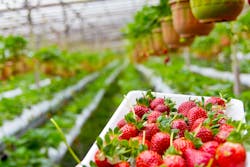If you subscribe to the LEDs Magazine News & Insights newsletter, you have once again seen in today’s edition a section on the wonders of website analytics. For a person who is absolutely terrible at math, I do find the behavioral analytics interesting. The most-read content on our website in the month of April was clearly on the topic of ultraviolet (UV) light for disinfection and sterilization. People were searching high and low for information about UV LEDs, especially regarding claims of killing the novel coronavirus.
Now, we have stated in several newsletters and in a recent blog that there are experts who are studying UV radiation for these applications, and knowledgeable organizations offering educational resources for both the public and for those developing products with safety and application guidelines in mind. For more recent quality information on germicidal UV, look to the IES for a report and other resources, as well as a new video interview by the National Lighting Bureau (NLB) with several scientists from the Lighting Research Center (LRC).
However, there are other cool ways UV light might be applied for the greater good — in the field of horticultural lighting. I’m more than pleased to take a break from focusing on the coronavirus.
1. UV light fights pathogens in plant applications.
In the rush of information about how to kill microorganisms that are harmful to humans, you might have missed that plants get “sick,” too. In search of potential replacements for chemical pesticides, fungicides, and so forth, researchers have explored the viability of UV light to protect crops from damage. Several such studies have been reported at our past Horticultural Lighting Conferences. At the inaugural event, LRC plant pathologist Jaimin Patel spoke in detail about enlisting UV-based solid-state lighting (SSL) in the fight against powdery mildew, again in strawberries, which can ruin entire crops. And LRC scientists continue to investigate various wavelengths, light recipes, and cultivar responses to UV.
2. UV light recipes may boost desired qualities of various cultivars.
Plants respond to every stimulus in their environment, from soil nutrients to watering frequency, airborne chemicals to the amount and kind of light they receive. Additional UV studies have indicated that UV light can influence the taste, smell, and appearance of food cultivars and even enhance the terpene content of cannabis crops, as SETi’s (Sensor Electronic Technology Inc.) Peter Barber explained at length during the 2018 Horticultural Lighting Conference.
3. UV-B light may increase the shelf life of picked produce.
Several years back, we reported that SETi and the US Department of Agriculture (USDA) concluded a study in which strawberries contained inside refrigerators were exposed to UV-C and UV-B light, with an unlit sample for control. The unlit sample showed signs of mold and decay after just three days. After nine days, strawberries lit with UV-C (100–280-nm) LEDs were free of mold but did show signs of decay. The sample lit with UV-B (280–315-nm) LEDs was mold- and decay-free after nine days. Keep in mind that UV LEDs can still be more challenging and expensive to produce, which is what has kept their advance into commercial products at more sedate pace compared to the general lighting sector.
For up-to-the-minute LED and SSL updates, why not follow us on Twitter? You’ll find curated content and commentary, as well as information on industry events, webcasts, and surveys on our LinkedIn Company Page and our Facebook page.

Carrie Meadows | Editor-in-Chief, LEDs Magazine
Carrie Meadows has more than 20 years of experience in the publishing and media industry. She worked with the PennWell Technology Group for more than 17 years, having been part of the editorial staff at Solid State Technology, Microlithography World, Lightwave, Portable Design, CleanRooms, Laser Focus World, and Vision Systems Design before the group was acquired by current parent company Endeavor Business Media.
Meadows has received finalist recognition for LEDs Magazine in the FOLIO Eddie Awards, and has volunteered as a judge on several B2B editorial awards committees. She received a BA in English literature from Saint Anselm College, and earned thesis honors in the college's Geisel Library. Without the patience to sit down and write a book of her own, she has gladly undertaken the role of editor for the writings of friends and family.
Meadows enjoys living in the beautiful but sometimes unpredictable four seasons of the New England region, volunteering with an animal shelter, reading (of course), and walking with friends and extended "dog family" in her spare time.





